Introducing RoadmapOne Version 3
Your Feedback Made This

We’re thrilled to announce RoadmapOne Version 3—our most significant release yet, shaped entirely by what you told us you needed.
Over the past six months, we’ve listened to hundreds of product teams using RoadmapOne to connect their roadmaps to measurable business outcomes. You told us what was working, what wasn’t, and what was missing. Version 3 is our response—a complete reimagining of how product teams plan, prioritize, and demonstrate strategic alignment.
This isn’t an incremental update. This is RoadmapOne rebuilt around five game-changing capabilities that transform how you work.
What’s New: Five Breakthroughs That Change Everything
1. Full Collaborative Editing: Your Team, One Roadmap, Real-Time
Gone are the days of “Can you share your screen?” or “Who has the latest version?”
Version 3 introduces full collaborative editing across your entire roadmap. Multiple team members can now edit simultaneously—moving objectives, adjusting allocations, updating sprint plans—all in real-time. You see changes as they happen. No conflicts. No overwrites. No confusion about who changed what.
Think Google Docs, but for strategic roadmap planning.
Why this matters: Product roadmaps aren’t solo activities. They’re collaborative conversations between product, engineering, design, and leadership. Yet most roadmapping tools force you into sequential editing or locked views that break flow. We’ve watched teams waste hours in video calls because only one person could edit while others watched.
Collaborative editing means your product trio can build the roadmap together. Your engineering lead adjusts capacity while your PM refines objectives. Your designer moves initiatives to better align with design sprint cycles. Everyone works in the same space, seeing the same truth, making decisions faster.
What changed behind the scenes: We rebuilt our entire state management system using operational transformation algorithms similar to what powers Google Docs and Figma. Your changes sync instantly across all connected clients. Conflicts are resolved automatically. Undo works across the full collaboration session. And if connectivity drops, you keep working—your changes sync when you’re back online.
This was months of engineering work. But watching teams use it makes every hour worth it.
2. Discovery Activities: Making Learning Visible
Here’s an uncomfortable truth: most roadmaps only show delivery work. They track when features ship but ignore the discovery work that determines whether you’re building the right things.
This creates a dangerous dynamic. Stakeholders see “slow progress” because discovery time is invisible. Teams feel pressure to skip discovery and jump straight to delivery. And products fail because nobody validated assumptions before burning months of engineering time.
Version 3 makes discovery a first-class citizen in your roadmap.
When you create an allocation, simply click “Mark as Discovery” in the Allocation Modal, set your start and end dates, and discovery work appears distinctly in your roadmap view. You can now show stakeholders: “Squad A is in discovery on the retention objective for the next two sprints. Squad B is delivering previously validated solutions. Squad C is splitting time between both.”
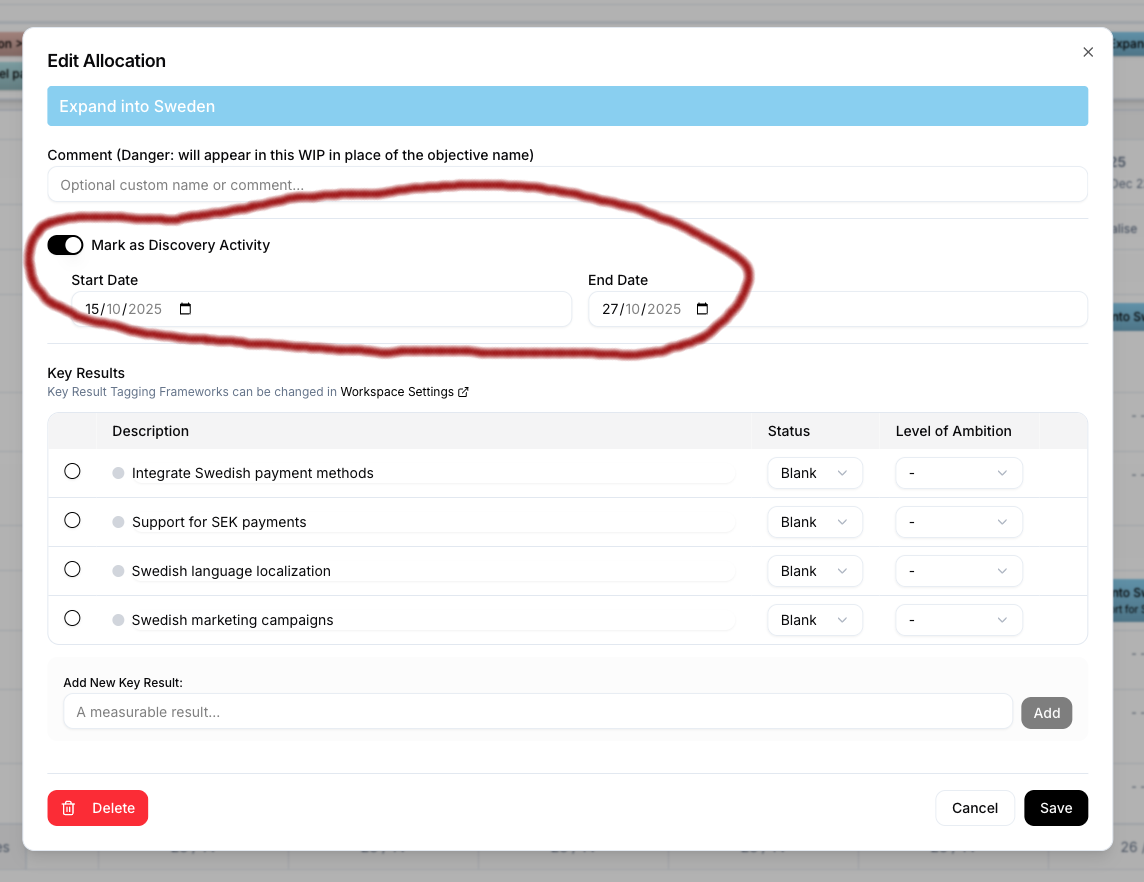 Mark allocations as Discovery activities with a single toggle—making this critical work visible.
Mark allocations as Discovery activities with a single toggle—making this critical work visible.
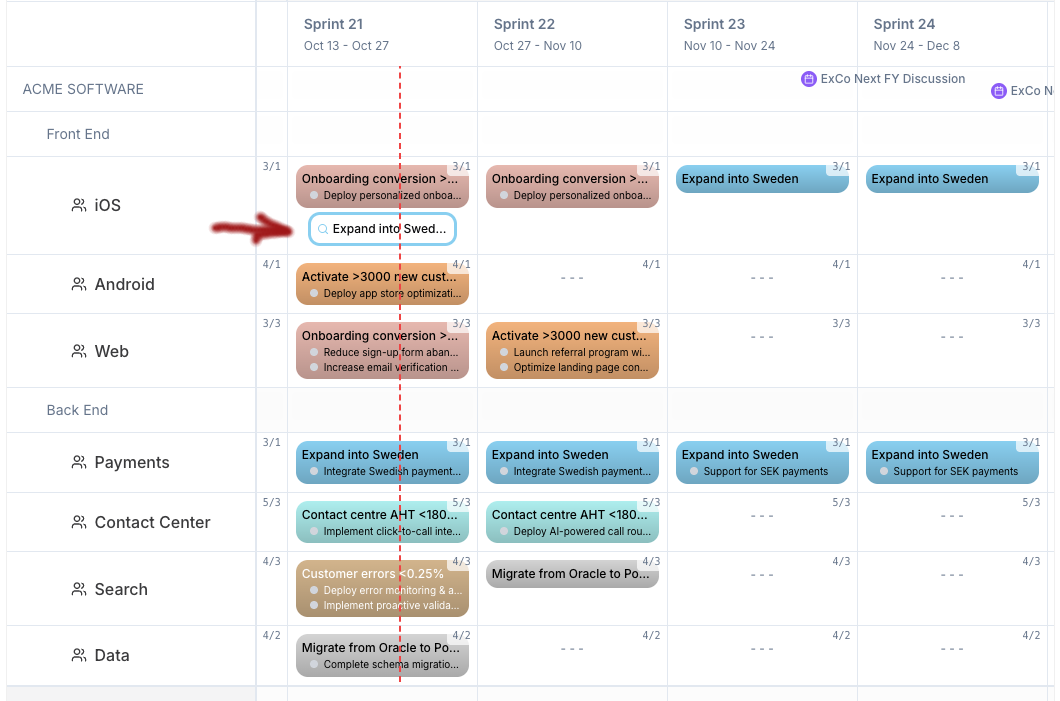 Discovery allocations appear clearly in your roadmap, showing which squads are validating vs. delivering.
Discovery allocations appear clearly in your roadmap, showing which squads are validating vs. delivering.
Why Discovery deserves first-class status: As Silicon Valley Product Group (SVPG) emphasizes, product discovery is where teams validate assumptions, understand customer problems deeply, and determine which solutions will actually deliver value. Marty Cagan describes discovery as answering two fundamental questions: Do customers want this? Can we build a solution that’s valuable, usable, feasible, and viable?
Discovery isn’t overhead that slows delivery—it’s investment that accelerates it. Teams that skip discovery waste months building the wrong things. Teams that invest in discovery build solutions that work the first time.
But discovery only works if it’s visible, valued, and measurable. When discovery is hidden, it becomes the first thing cut when stakeholders push for faster delivery. When discovery is explicit in your roadmap, you can:
- Defend discovery time with data: “30% of our capacity is allocated to discovery this quarter”
- Balance discovery and delivery appropriately: High-uncertainty initiatives get more discovery; low-uncertainty work gets less
- Track discovery outcomes: What did we learn? Which assumptions were validated? How did discovery change our approach?
- Communicate progress clearly: “We’re not ‘behind’—we’re validating before we commit development resources”
Discovery is also the critical moment where teams break down business objectives into specific, measurable key results. Leadership sets objectives like “Increase trial-to-paid conversion from 15% to 25%.” Discovery is where the product trio validates which specific key results will move that objective: “Reduce time-to-first-value from 48 hours to 4 hours” or “Increase activation completion rate from 40% to 65%.”
This is the SVPG Product Model in action: leadership allocates objectives to teams; empowered teams use discovery to determine how to achieve them.
Version 3 makes this visible. Your roadmap now shows both the journey (discovery) and the destination (delivery). Stakeholders finally see the full picture.
3. Objective Prioritisation: 15 Frameworks, Fully Customizable
“Which objectives should we fund first?” This is the most important question in product strategy—and the hardest to answer.
Most teams either:
- Use gut feel and politics (leading to unfocused roadmaps and endless debates)
- Adopt a single framework religiously (which breaks when context changes)
- Spend weeks debating frameworks without ever scoring objectives
Version 3 introduces comprehensive Objective Prioritisation with fifteen battle-tested frameworks, each optimized for different organizational contexts and decision-making cultures.
You can now prioritize using RICE (Reach × Impact × Confidence ÷ Effort), ICE (Impact × Confidence × Ease), MoSCoW (Must/Should/Could/Won’t buckets), WSJF (Weighted Shortest Job First), Value/Complexity matrix, BRICE (Business Importance × RICE), Opportunity Scoring (customer dissatisfaction gaps), PIE (Potential × Importance × Ease), NPV (Net Present Value), ARR (Annual Recurring Revenue impact), Kano (Must-Haves → Performance → Delighters), Cost of Delay, Payback Period, Buy a Feature, or Manual prioritization.
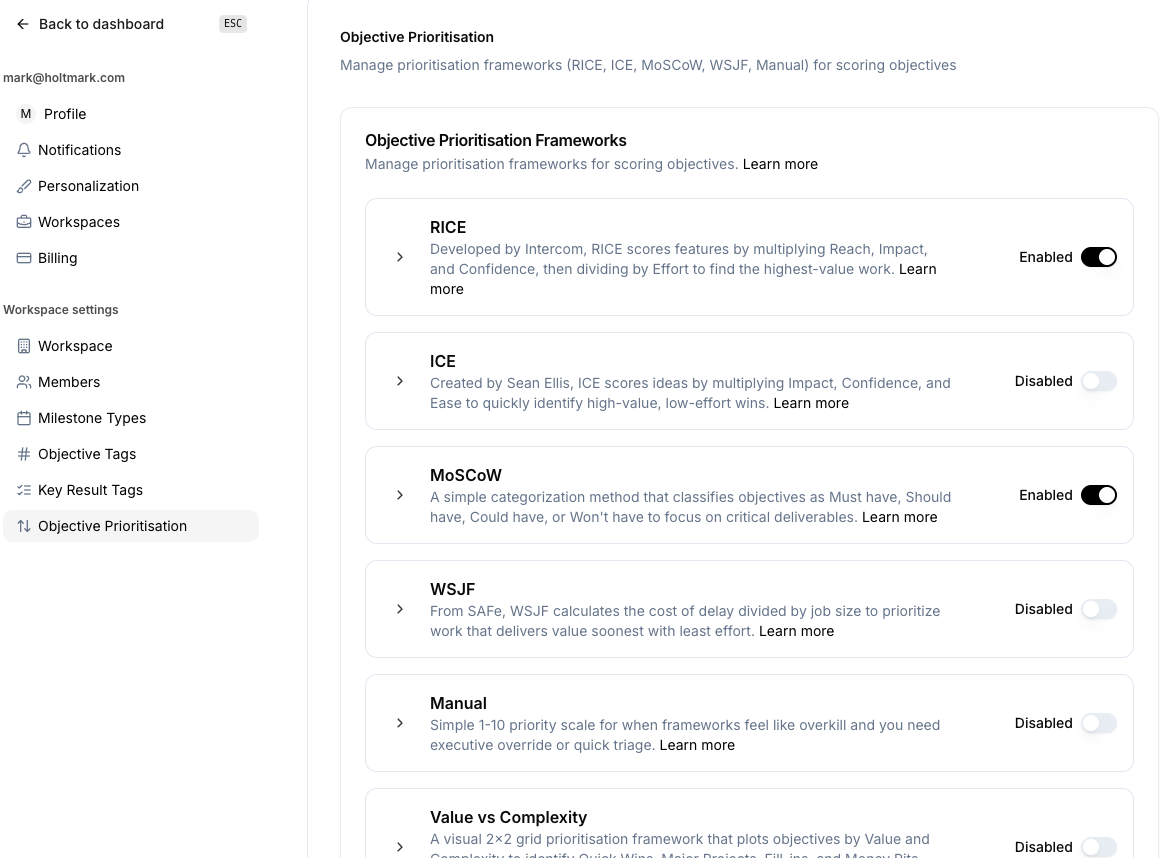 Choose from 15 prioritisation frameworks or create your own—each optimized for different strategic contexts.
Choose from 15 prioritisation frameworks or create your own—each optimized for different strategic contexts.
Better yet: every framework is fully customizable. Don’t like how RICE weights confidence? Change it. Need to add a strategic alignment dimension to ICE? Add it. Want to create a completely custom framework that matches your organization’s unique decision criteria? Build it.
Why fifteen frameworks? Because there’s no “best” prioritization approach. The right framework depends on your data maturity, decision-making culture, and strategic context:
- Use RICE when you have reliable reach and impact data
- Use ICE when speed matters more than precision (startups, early-stage)
- Use MoSCoW when stakeholders need scope trade-offs visualized brutally
- Use WSJF if you’re in SAFe and need to speak its language
- Use Manual when frameworks create more heat than light
- Use Value/Complexity when executives need visual quadrants
- Use BRICE when RICE needs strategic alignment
- Use Opportunity Scoring when customer gaps drive strategy
- Use PIE when running growth experiments
- Use NPV for multi-year investments requiring board approval
- Use ARR when protecting recurring revenue drives decisions
- Use Kano when customer satisfaction psychology matters
- Use Cost of Delay when market timing dominates
- Use Payback Period when cash flow and liquidity matter most
- Use Buy a Feature for stakeholder alignment workshops
Each framework solves the sequencing problem differently. Pick the one that matches your current context, score your objectives, sort by rank, and draw the capacity line. Everything above the line gets funded. Everything below waits.
The scoring conversation is often more valuable than the scores themselves—teams discover they’ve been arguing about priorities using completely different invisible assumptions. Making those assumptions explicit and numerical transforms roadmap debates from political to empirical.
Learn more about all 15 frameworks →
4. Expanded Key Result Tagging: Measuring What Actually Matters
Objectives tell you where to go. Key Results tell you whether you’ve arrived. But here’s the problem: most teams measure outputs disguised as outcomes, mistake activity for impact, and report confidence levels that evaporate under scrutiny.
Version 3 expands Key Result tagging to help you categorize and validate every metric, ensuring teams optimize for outcomes that actually move the business.
Key Result tagging now supports seven comprehensive frameworks: R&D Tax Credit qualification tracking, Level of Ambition (stretch vs. committed goals), Committed vs Stretch Goals (stakeholder expectation calibration), Outcome vs Output vs Input (are you measuring impact, deliverables, or just activity?), Confidence Level % (how confidence evolves over time), Validation Method (hypothesis-driven vs. assumption-gambling), and Metric Type (quantitative vs. qualitative vs. binary).
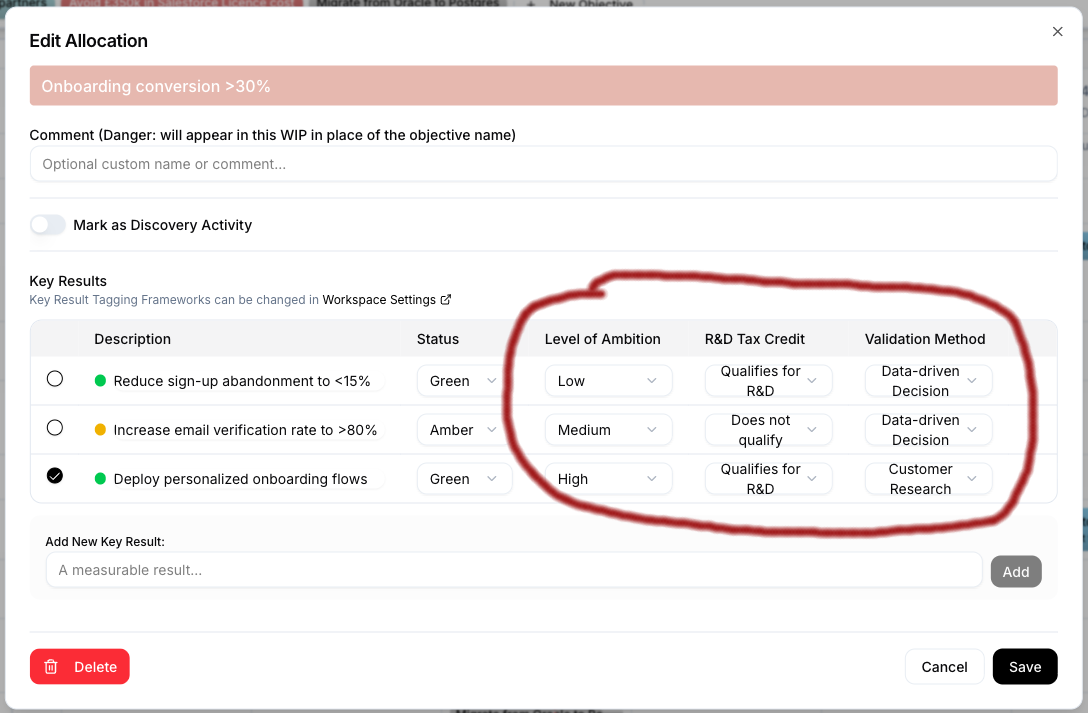 Tag key results to reveal whether you’re measuring the right things with the right confidence using the right methods.
Tag key results to reveal whether you’re measuring the right things with the right confidence using the right methods.
Why this transforms measurement: Without tagging, key results are just numbers on a page. With tagging, you gain:
- Measurement hygiene: Distinguish outcomes from outputs from inputs, preventing teams from celebrating activity while impact stalls
- Risk transparency: Confidence and validation tags surface which results are data-driven versus assumption-based
- Portfolio intelligence: Dashboards reveal imbalances—like 80% quantitative metrics when qualitative insights would better guide decisions
- Evidence-based governance: Boards see not just numbers but the quality and confidence behind them
Start by auditing your current key results with the Outcome vs Output vs Input framework. You’ll likely discover that 70% of your “key results” are actually outputs or inputs dressed up as outcomes. This revelation alone transforms how teams think about measurement.
Then layer in Confidence Level tracking. Watch confidence evolve as teams gather evidence. Low confidence isn’t weakness—it’s honesty. High confidence without validation is delusion.
Finally, add Validation Method tags. Are you hypothesis-driven or assumption-gambling? Teams shift from “we think this works” to “here’s our hypothesis, here’s our test, here’s what we learned.”
Explore all 7 Key Result frameworks →
5. More Objective Tagging Frameworks: Strategic Categorization That Matters
Version 3 expands Objective tagging with five powerful new frameworks that help you understand whether your roadmap aligns with strategic intent.
The new frameworks include: Core vs Context (are you spending elite talent on differentiators, not plumbing?), BCG Growth-Share Matrix (are you milking Cash Cows and feeding Stars intentionally?), Kano Model (are you balancing basics, performance, and delight?), Customer Journey Stage (are you investing across the full customer lifecycle?), and Jobs-to-be-Done (are you solving the right functional, emotional, and social jobs?).
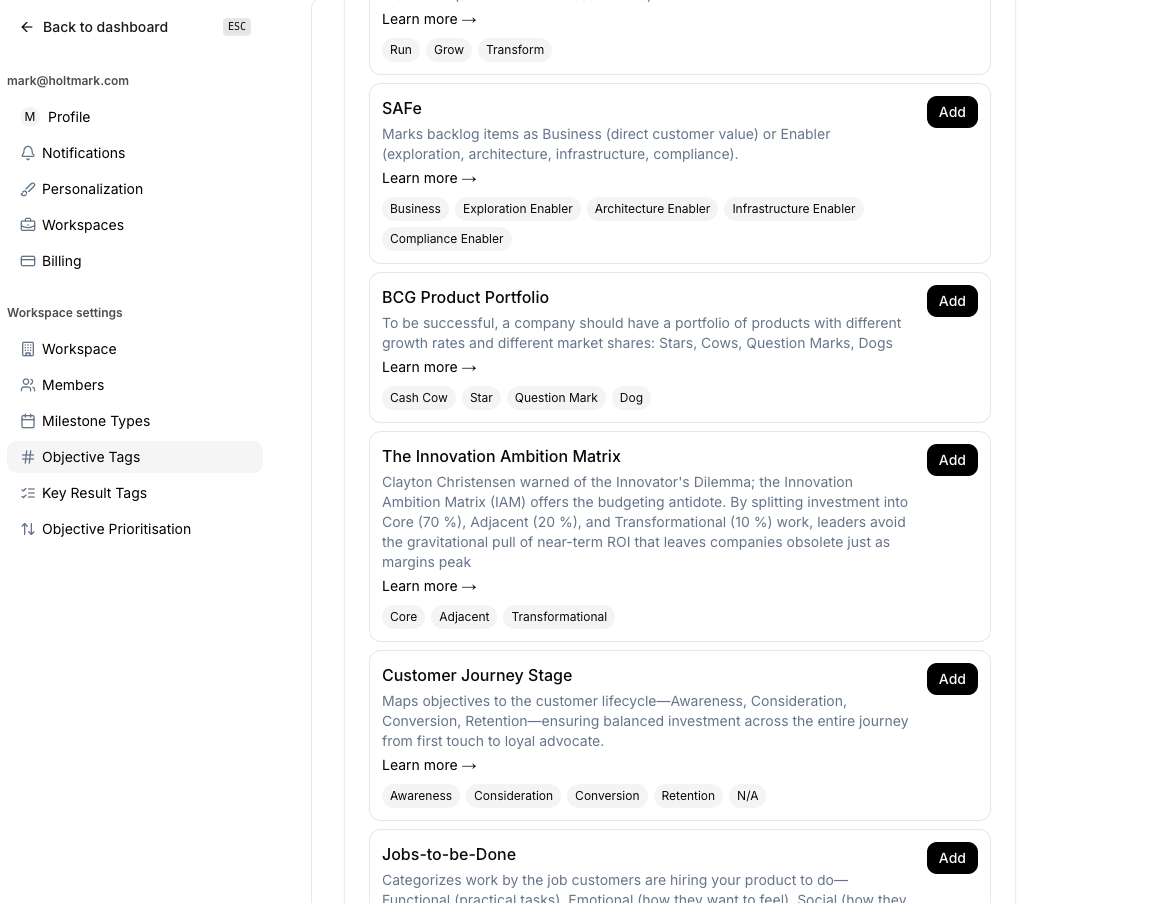 Twelve objective tagging frameworks help you categorize work and analyze portfolio balance.
Twelve objective tagging frameworks help you categorize work and analyze portfolio balance.
Combined with our existing frameworks—Run·Grow·Transform , Three Horizons , SAFe Enabler vs Business , AARRR Funnel , Balanced Scorecard , SVPG Product Risks , and Innovation Ambition Matrix —you now have twelve strategic lenses for roadmap analysis.
Why tagging matters: Objective prioritisation tells you which objectives to fund first. Objective tagging tells you whether you’re funding a balanced portfolio.
Imagine running RICE prioritisation and discovering the top 20 objectives are all “Run ” work with zero “Transform ” objectives above the funding line. RICE did its job—it ranked by value per effort—but your portfolio is now optimized for operational efficiency while competitors are building your replacement.
Tagging surfaces the imbalance. You can then re-weight your scoring dimensions or accept that this quarter is about operational excellence and plan a Transform-heavy next quarter.
Or use Core vs Context tagging to reveal that 60% of engineering capacity is going to undifferentiated plumbing instead of competitive advantage. That’s a strategic problem no amount of velocity optimization will fix.
Or apply Kano Model tagging to discover your roadmap is all performance improvements with zero delighters. You’re meeting expectations but creating no customer love.
Tagging and prioritisation form a feedback loop. Prioritisation builds the roadmap. Tagging analyzes whether the roadmap aligns with strategic intent. The analysis informs the next prioritisation cycle’s weights and criteria.
Discover all 12 Objective tagging frameworks →
Plus: The Invisible Improvements That Make Everything Better
Beyond these five headline features, Version 3 includes dozens of improvements you’ll feel but might not notice:
Major performance optimizations: Roadmaps with 100+ objectives and 20+ squads now load 3-5x faster. Collaborative editing stays smooth even with 10+ simultaneous users. Analytics dashboards that previously took 8 seconds to render now appear in under 2 seconds.
Extensive bug fixes: We’ve addressed over 150 reported issues, from edge cases in sprint date calculations to visual glitches in analytics filters to sync conflicts in multi-user scenarios. Every bug fix came from your feedback—thank you for reporting them.
Improved analytics rendering: Charts are crisper, legends are clearer, and export functionality is more reliable. We’ve also added new filtering options that let you drill into exactly the portfolio slice you need.
Enhanced mobile experience: While RoadmapOne remains best experienced on desktop for heavy roadmap editing, Version 3 significantly improves mobile viewing for quick updates and stakeholder presentations on the go.
Accessibility improvements: We’ve enhanced keyboard navigation, improved screen reader support, and increased color contrast ratios throughout the application.
What Our Customers Are Saying
“Discovery activities being visible in the roadmap changed how our executive team thinks about our capacity. They finally understand why we need time to validate before we build.” — Sarah Chen, VP Product, SaaS Scale-up
“The collaborative editing is a game-changer. Our product trio can now work on the roadmap together instead of screen-sharing in Zoom calls. We’re moving so much faster.” — James Rodriguez, Senior Product Manager, FinTech
“Having 15 prioritization frameworks means we can adapt as our company matures. We started with ICE when we were pre-product-market-fit. Now we use RICE with confidence because we have the data. Same tool, different stage.” — Emily Watson, Head of Product, Healthcare Tech
How We Built This: Your Feedback, Our Roadmap
Every feature in Version 3 came directly from conversations with you—our customers.
You told us collaborative editing was essential because roadmaps are team activities, not solo exercises. You told us discovery was getting squeezed because it wasn’t visible to stakeholders. You told us you needed more prioritization options because one-size-fits-all frameworks don’t match organizational reality. You told us key results needed better categorization because measurement quality matters as much as the metrics themselves.
We listened. We built. And we’re not done.
This is the RoadmapOne model: ruthless focus on connecting product roadmaps to measurable business outcomes, shaped by what you tell us you need. Version 3 is proof that feedback-driven development works—when you actually listen and act on it.
What’s Next: The Version 4 Roadmap
We’re already deep into planning for Version 4, with several major capabilities in discovery:
- Advanced scenario planning: Create multiple “what-if” roadmaps and compare them side-by-side to evaluate trade-offs before committing
- Integration ecosystem: Direct connections to Jira, Linear, Asana, and other delivery tools to sync objectives with execution
- AI-powered insights: Surface patterns in your historical data that reveal what actually drives outcomes
- Custom analytics dashboards: Build your own views that answer your organization’s unique strategic questions
- Team capacity forecasting: Project future capacity based on hiring plans, attrition trends, and historical velocity
These aren’t promises—they’re initiatives currently in discovery, being validated with customers like you. If you want to influence what we build, reach out —we’re always listening.
Getting Started with Version 3
For existing customers: Version 3 is rolling out automatically over the next week. You’ll receive an in-app notification when it’s available for your workspace. No action required—just log in and explore.
For new users: Sign up now and experience the most powerful way to connect your product roadmap to measurable business outcomes.
Migration notes: All your existing data—objectives, allocations, tags, priorities—carries forward seamlessly. Discovery allocations default to “Delivery” for existing work; simply toggle to “Discovery” where appropriate. Prioritization scores need to be recalculated using your chosen framework. Key Result and Objective tags remain unchanged.
Training and support: We’ve updated our documentation, created new video tutorials for each major feature, and our support team is standing by to help with any questions. Existing customers will receive invitations to live onboarding sessions over the next two weeks.
Why RoadmapOne Exists
We built RoadmapOne because traditional roadmapping tools focus on tracking features, not delivering outcomes. They’re project management tools dressed up as strategy tools. They don’t answer the questions that actually matter:
- Are we working on objectives that move the business?
- Do we have appropriate capacity allocated based on uncertainty and risk?
- Are our key results measuring outcomes or just outputs?
- Is our portfolio balanced across strategic dimensions?
- Can we demonstrate to stakeholders why we’re funding these objectives over others?
RoadmapOne answers these questions. It connects daily product work to quarterly business results. It makes strategy visible, measurable, and actionable.
Version 3 makes that connection stronger, clearer, and more powerful than ever.
Thank You
To every customer who shared feedback, reported bugs, requested features, and pushed us to build something better: thank you. This release is yours.
To every product manager fighting to connect their roadmap to business outcomes, to make discovery visible, to defend why you’re building what you’re building: this tool is for you.
To every team trying to align product, engineering, design, and leadership around outcomes that matter: we built this to make your work easier and your impact greater.
Welcome to RoadmapOne Version 3. Let’s build products that move the business.
About RoadmapOne
RoadmapOne is the roadmap planning and governance tool that helps product teams ensure appropriate resources are allocated to the highest priority objectives throughout the planning year. Founded by product and engineering leaders with decades of experience, RoadmapOne focuses relentlessly on connecting product work to measurable business outcomes.
Learn More:
- Product Discovery in Roadmaps - Why discovery activities deserve first-class status
- Objective Prioritisation Guide - Deep dive into all 15 frameworks
- Key Result Tagging Guide - Master the art of measuring what matters
- Objective Tagging Guide - Twelve lenses for strategic portfolio analysis